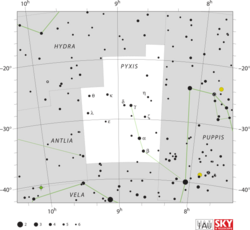Astronomy:Zeta Pyxidis
| Observation data Equinox J2000.0]] (ICRS) | |
|---|---|
| Constellation | Pyxis |
| Right ascension | 08h 39m 42.47410s[1] |
| Declination | −29° 33′ 39.8989″[1] |
| Apparent magnitude (V) | +4.88[2] (4.97 + 9.59)[3] |
| Characteristics | |
| Spectral type | G6 IIIb CN-0.5[4] |
| B−V color index | +0.90[2] |
| Astrometry | |
| Radial velocity (Rv) | −30.10[5] km/s |
| Proper motion (μ) | RA: −24.81[1] mas/yr Dec.: −90.96[1] mas/yr |
| Parallax (π) | 13.35 ± 0.23[1] mas |
| Distance | 244 ± 4 ly (75 ± 1 pc) |
| Absolute magnitude (MV) | +0.49[6] |
| Details | |
| ζ Pyx A | |
| Mass | 1.96[5] M☉ |
| Luminosity | 69[5] L☉ |
| Surface gravity (log g) | 2.72±0.06[7] cgs |
| Temperature | 4,876±8[5] K |
| Metallicity [Fe/H] | −0.43±0.02[7] dex |
| Age | 1.88[5] Gyr |
| Other designations | |
| Database references | |
| SIMBAD | data |
Zeta Pyxidis (ζ Pyxidis) is a wide binary star[9] system in the southern constellation of Pyxis. It is visible to the naked eye with a combined apparent visual magnitude of +4.88.[2] Based upon an annual parallax shift of 13.35 mas as seen from Earth,[1] it is located around 244 light years from the Sun.
The yellow-hued primary, component A, is an evolved G-type giant star with a stellar classification of G6 IIIb CN-0.5,[4] where the suffix notation indicating it has anomalously weak lines of cyanogen. At the age of 1.88 billion years,[5] is a red clump star that is generating energy through the fusion of helium at its core.[10] The primary has nearly double the mass of the Sun and is radiating 69 times the Sun's luminosity from its photosphere at an effective temperature of 4,876 K.[5]
The companion, component B, is a magnitude 9.59 star at an angular separation of 52.20 arc seconds along a position angle of 61°, as of 2010.[3]
References
- ↑ 1.0 1.1 1.2 1.3 1.4 1.5 van Leeuwen, F. (2007), "Validation of the new Hipparcos reduction", Astronomy and Astrophysics 474 (2): 653–664, doi:10.1051/0004-6361:20078357, Bibcode: 2007A&A...474..653V.
- ↑ 2.0 2.1 2.2 Cousins, A. W. J. et al. (1966), "Photoelectric magnitudes and colours of southern stars, II", Royal Observatory Bulletins 121: 1, Bibcode: 1966RGOB..121....1C.
- ↑ 3.0 3.1 Mason, B. D. et al. (2014), "The Washington Visual Double Star Catalog", The Astronomical Journal 122 (6): 3466, doi:10.1086/323920, Bibcode: 2001AJ....122.3466M
- ↑ 4.0 4.1 Keenan, Philip C.; McNeil, Raymond C. (1989), "The Perkins catalog of revised MK types for the cooler stars", Astrophysical Journal Supplement Series 71: 245, doi:10.1086/191373, Bibcode: 1989ApJS...71..245K.
- ↑ 5.0 5.1 5.2 5.3 5.4 5.5 5.6 Luck, R. Earle (2015), "Abundances in the Local Region. I. G and K Giants", The Astronomical Journal 150 (3): 88, doi:10.1088/0004-6256/150/3/88, Bibcode: 2015AJ....150...88L.
- ↑ Anderson, E.; Francis, Ch. (2012), "XHIP: An extended hipparcos compilation", Astronomy Letters 38 (5): 331, doi:10.1134/S1063773712050015, Bibcode: 2012AstL...38..331A.
- ↑ 7.0 7.1 Alves, S. et al. (April 2015), "Determination of the spectroscopic stellar parameters for 257 field giant stars", Monthly Notices of the Royal Astronomical Society 448 (3): 2749–2765, doi:10.1093/mnras/stv189, Bibcode: 2015MNRAS.448.2749A.
- ↑ "zet Pyx". SIMBAD. Centre de données astronomiques de Strasbourg. http://simbad.u-strasbg.fr/simbad/sim-basic?Ident=zet+Pyx.
- ↑ Eggleton, P. P.; Tokovinin, A. A. (September 2008), "A catalogue of multiplicity among bright stellar systems", Monthly Notices of the Royal Astronomical Society 389 (2): 869–879, doi:10.1111/j.1365-2966.2008.13596.x, Bibcode: 2008MNRAS.389..869E.
- ↑ Alves, David R. (August 2000), "K-Band Calibration of the Red Clump Luminosity", The Astrophysical Journal 539 (2): 732–741, doi:10.1086/309278, Bibcode: 2000ApJ...539..732A.
 |


